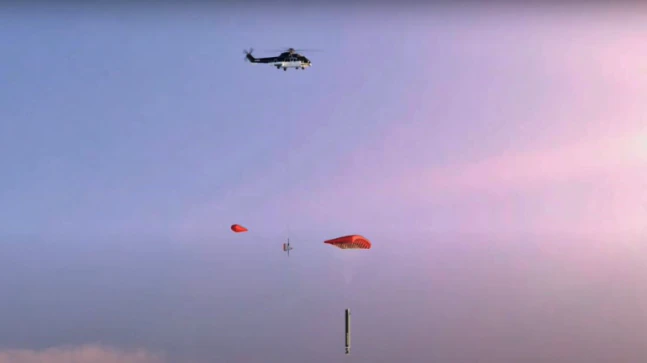Reusable boosters are the biggest leap forward to ensure regular and cheap space transportation, and SpaceX has pioneered the technology by successfully landing over 100 boosters from space. It now has a competition.
Rocket Lab, a US-based launch company, is planning to catch a booster falling from space mid-air using a helicopter. The launch company will test the new technology during its next Electron launch slated on April 29-30. The company will attempt the maiden capture after the Electron launch vehicles deploy rideshare satellites and fall back to the planet.
The company has released a video showing how it will be done, where the team is seen practicing the mid-air capture using a helicopter tether.
WATCH HERE
While we await ideal weather conditions for #ThereAndBackAgain, the recovery team has been conducting capture tests using a stage 1 mass simulator. Our pilots make this look easy! pic.twitter.com/1r6PZvzBni
— Rocket Lab (@RocketLab) April 26, 2022
While the SpaceX’s Falcon-9 rockets use grid fins and thrusters to stabilise it and slow it down during re-entry after jettisoning from the payload, Rocket lab’s Electron launch vehicle uses parachutes to slow it down. This parachute is then hooked by a tether onboard a helicopter capturing the falling booster.
Dubber “There and Back Again”, the mission will see the deployment of 34 payloads from commercial operators Alba Orbital, Astrix Astronautics, Aurora Propulsion Technologies, E-Space, Unseenlabs, and Swarm Technologies via global launch services provider Spaceflight Inc. Once the first stage separates, Rocket Lab will also attempt a mid-air capture to make Electron a reusable rocket.
HOW WILL HELICOPTER CATCH BOOSTER FALLING FROM SPACE?
An hour before launch, the company’s Sikorsky S-92 helicopter will fly to the capture zone taking position approximately 150 nautical miles off New Zealand’s coast. Nearly 2: 30 minutes after launch, the Electron launch vehicle (first stage) will separate, as the second stage pushes forward, the boosters will begin its descent back to Earth reaching speeds of almost 8,300 kilometers per hour.
During its re-entry, the booster will feel the heat of Earth’s atmosphere reaching a temperature of 2,400 degrees Celsius. The launch vehicle will deploy a drogue parachute at an altitude of 13 kilometers above the surface followed by the main parachute at six kilometers. This will slow down the free-falling rocket to 36 km per hour.
This is when the Sikorsky S-92 will come into play, attempting to rendezvous with the returning stage and cap

